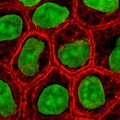Cell culture
Cell culture is a fundamental technique in the field of cell biology where cells are grown under controlled conditions. The practice of cell culture has played a significant role in scientific research, particularly in producing biological products and developing genetic engineering techniques.
History[edit]
The concept of cell culture was first introduced in the early 20th century. The initial experiments were conducted by Ross Granville Harrison and Alexis Carrel, who successfully cultivated animal tissues in vitro. This marked the beginning of cell culture technology.
Types of Cell Culture[edit]
There are several types of cell culture, including primary cell culture, secondary cell culture, and cell line.
Primary Cell Culture[edit]
Primary cell culture is the process of disassociating cells from a parental tissue, which is then grown in a suitable medium. These cells maintain the physiological properties of the original tissue.
Secondary Cell Culture[edit]
Secondary cell culture, also known as cell line or subculture, involves the process of transferring the cells from a primary culture into a new vessel. This allows for the prolongation of the culture beyond the lifespan of the primary cells.
Cell Line[edit]
A cell line is a permanently established cell culture that proliferates indefinitely given appropriate fresh medium and space.
Techniques[edit]
Cell culture techniques vary depending on the type of cells being cultured. The most common techniques include monolayer culture, suspension culture, and three-dimensional culture.
Monolayer Culture[edit]
In monolayer culture, cells are grown in a single layer on a glass or plastic surface.
Suspension Culture[edit]
Suspension culture involves the growth of cells in a medium, where the cells multiply while suspended in the liquid.
Three-Dimensional Culture[edit]
Three-dimensional culture, also known as 3D culture, is a technique where cells are grown in a 3D environment. This method is often used to mimic the in vivo conditions.
Applications[edit]
Cell culture has a wide range of applications in various fields such as virology, oncology, pharmacology, and genetics. It is used for the production of vaccines, therapeutic proteins, and testing drug efficacy and toxicity.
Challenges[edit]
Despite its numerous applications, cell culture faces several challenges including contamination, genetic drift, and ethical issues.

This article is a cell biology stub. You can help WikiMD by expanding it!
Cell_culture[edit]
-
Cell culture in a tiny Petri dish
-
Epithelial cells
-
CHO cells adherent
-
DMEM cell culture medium
-
HeLa cells stained with Hoechst 33258
-
Cell culture
Ad. Transform your life with W8MD's Budget GLP-1 injections from $75


W8MD offers a medical weight loss program to lose weight in Philadelphia. Our physician-supervised medical weight loss provides:
- Weight loss injections in NYC (generic and brand names):
- Zepbound / Mounjaro, Wegovy / Ozempic, Saxenda
- Most insurances accepted or discounted self-pay rates. We will obtain insurance prior authorizations if needed.
- Generic GLP1 weight loss injections from $75 for the starting dose.
- Also offer prescription weight loss medications including Phentermine, Qsymia, Diethylpropion, Contrave etc.
NYC weight loss doctor appointmentsNYC weight loss doctor appointments
Start your NYC weight loss journey today at our NYC medical weight loss and Philadelphia medical weight loss clinics.
- Call 718-946-5500 to lose weight in NYC or for medical weight loss in Philadelphia 215-676-2334.
- Tags:NYC medical weight loss, Philadelphia lose weight Zepbound NYC, Budget GLP1 weight loss injections, Wegovy Philadelphia, Wegovy NYC, Philadelphia medical weight loss, Brookly weight loss and Wegovy NYC
|
WikiMD's Wellness Encyclopedia |
| Let Food Be Thy Medicine Medicine Thy Food - Hippocrates |
Medical Disclaimer: WikiMD is not a substitute for professional medical advice. The information on WikiMD is provided as an information resource only, may be incorrect, outdated or misleading, and is not to be used or relied on for any diagnostic or treatment purposes. Please consult your health care provider before making any healthcare decisions or for guidance about a specific medical condition. WikiMD expressly disclaims responsibility, and shall have no liability, for any damages, loss, injury, or liability whatsoever suffered as a result of your reliance on the information contained in this site. By visiting this site you agree to the foregoing terms and conditions, which may from time to time be changed or supplemented by WikiMD. If you do not agree to the foregoing terms and conditions, you should not enter or use this site. See full disclaimer.
Credits:Most images are courtesy of Wikimedia commons, and templates, categories Wikipedia, licensed under CC BY SA or similar.
Translate this page: - East Asian
中文,
日本,
한국어,
South Asian
हिन्दी,
தமிழ்,
తెలుగు,
Urdu,
ಕನ್ನಡ,
Southeast Asian
Indonesian,
Vietnamese,
Thai,
မြန်မာဘာသာ,
বাংলা
European
español,
Deutsch,
français,
Greek,
português do Brasil,
polski,
română,
русский,
Nederlands,
norsk,
svenska,
suomi,
Italian
Middle Eastern & African
عربى,
Turkish,
Persian,
Hebrew,
Afrikaans,
isiZulu,
Kiswahili,
Other
Bulgarian,
Hungarian,
Czech,
Swedish,
മലയാളം,
मराठी,
ਪੰਜਾਬੀ,
ગુજરાતી,
Portuguese,
Ukrainian





